Kiev-Pechersk Lavra
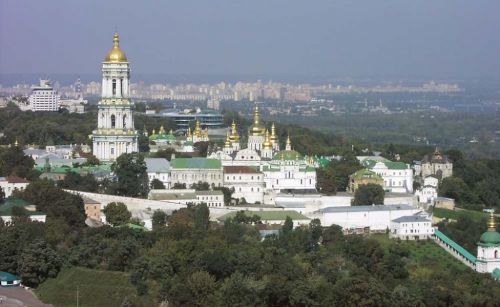
On the high hills of the right bank of the Dnieper rises majestically crowned with golden domes of Kiev-Pechersk Lavra - the inheritance of the Blessed Virgin Mary, the cradle of monasticism in Rus and the stronghold of the Orthodox religion. Monastyr Pechersk Lavra was founded in 11 century and was built in 9 following centuries . Name "Cave" is from the word "cave", which were found in this territory and in which the first monks settled. Laurus - that honorable title, which was given a very large and important monasteries. The architectural complex of the monastery produces a tremendous impression and today. On a sunny day, the reflections of numerous domes and belfries shine into your eyes. Many monastery buildings dates back to 17-18 centuries, and are excellent examples of Ukrainian Baroque style in architecture. Since 12 century only one church in the city now with minor architectural changes that were made later. The church over the gate of the main entrance to the monastery and it's called "Nadbramna. The full name of the Church - Trinity Church Nadbramnaya - Holy Trinity Church of Brahma. It was a miracle that it survived, since the monastery throughout history have committed numerous attacks. We, the tourists of XXI century, was lucky: we can see the restored monastery complex. Reconstructed the main sanctuary - the Assumption Cathedral, more than 60 years been lying in ruins. Complex Kiev-Pechersk Lavra entered the World Heritage List UNESKO. Lavra caves contain more than 200 relics of saints. On the territory of the monastery are a number of historical and cultural museums in Ukraine, including the famous Museum of Historical Treasures (Scythian Gold Museum), as well as the Museum of miniatures, typography, decorative folk art, music, theater, film, exhibitions of private collections. A separate exhibition on the history of the Lavra caves.
St Sophia Cathedral
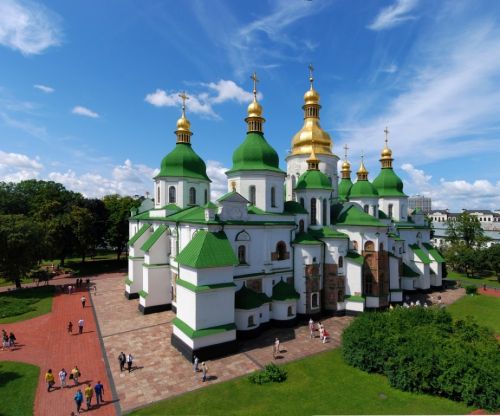
St Sophia Cathedral was built in the 11th century and is located in the heart of Kiev. 260 square meters of mosaics and 3,000 square meters of frescoes survived through the centuries and reached us through the ages. Hardly anywhere in Europe you can find so many frescoes and mosaics of the 11th century, which were preserved in one church. Cathedral is surrounded by monastic buildings of the 17th century, made in the style of Ukrainian Baroque. The interior of the cathedral is almost not changed. In the 18th century appeared iconostasis and in the 19th century - cast iron floor tiles. Saint Sophia - the source of art, to which historians and tourists come to see and admire this miracle of Byzantine and ancient Russian architecture.
Golden Gate

Golden Gate - the main gate of the ancient Kiev. Got its name from the similarity to the Golden Gate of Constantinople. Golden Gate of Kiev is one of the few buildings of Kievan Rus, which have come down to our day. Included in the UNESCO World Heritage List. Golden Gate was built in 1037 during the reign of the Grand Duke of Kiev Yaroslav Mudriy. Kiev those days was surrounded by high earthen ramparts with deep ditches on the outside. Golden Gate was part of the defensive structures and served as the main entrance to the city - it was a wide arch with a fighting platform above it, in the center of which was built a white stone church. This amazing creation of ancient architects caused delight of contemporaries and brought the horror on enemies its inaccessibility. In addition to defense purposes, Golden Gate had also triumphant nature - foreign ambassadors and distinguished guests weremet there, the soldiers were accompanied to defend the homeland, under the arches of the gate the prince's retinue were returning from patrol.
St. Andrew's Church
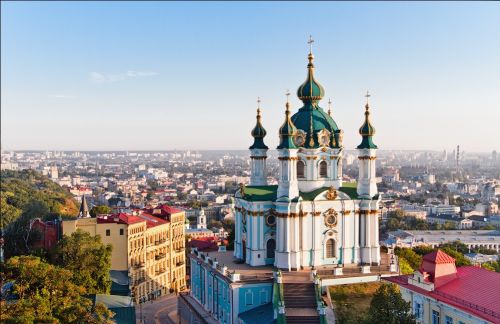
Baroque Pearl - Andrew's church, the building of which was started in 1744 in connection with the arrival of Elizabeth I in Kiev. Built in 1749 - 54 years and designed by Rastrelli at Mount St. Andrew, in the beginning of Andrew's descent. It is the only surviving work of the architect in Ukraine. Construction was led by architect I.Michurin. Five-domed church has the shape of a cross, at the corners of which the layout decorative tower on massive pillars, which plays the role of the buttresses. Outside buttresses adorned with pilasters and covered with three pairs of columns with capitals of the Corinthian order. By Andrew's Church from the street there is steep iron stairs. The entire mass of the church is based on the two-storey house stilobat with eight rooms on each floor, the walls of which are the foundation of the church. Around the church - a balustrade, which offers a picturesque view of the Dnipro river and Podol. The internal framing of St. Andrew's church, designed by Rastrelli, is more closer to the style of Rococo.
St. Michael's Golden-Domed Monastery
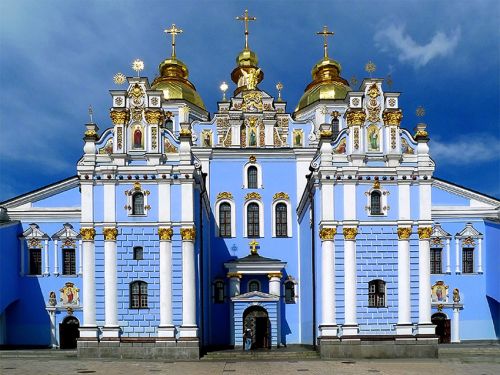
St. Michael's Golden-Domed Monastery - one of the oldest monasteries in Kiev. It includes destroyed in 1930 and re-built in the mid-1990s, the cathedral church of the Archangel Michael in the Ukrainian Baroque style, as well as the dining hall with the church of St. John the Divine (1713) and bell tower (1716-1719 years).
It is assumed that Michael's Cathedral was the first temple with a gilded dome, from here on Rus was founded this original tradition. Also, Michael's Cathedral was the last temple in Kievan Rus, in the interiors of which were used mosaic. Tradition ascribes the foundation of the monastery to the first metropolitan of Kiev Michael. The first temple in honor of the Archangel Michael was commissioned in 1108 by Prince Sviatopolk Izjaslavavich on the place of Demetrius monastery.Erected in 1108-1113 St. Michael's Cathedral was of particular importance to Kiev people because he was dedicated to the archangel Michael - patron saint of Kiev. In the XII century the monastery was the burial place of princes.
Museum of Folk Architecture and Life of Ukraine
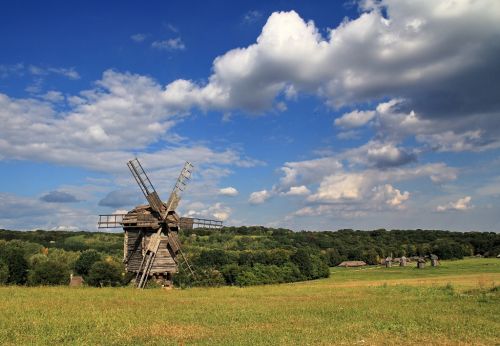
On the southern outskirts of Kiev, near the village of Pirogovo, where high hills with scenic views and a pleasant coolness attract blue-eyed rates, among the oak forests and groves is located the Museum of Folk Architecture and Life of Ukraine. Museum (total area - near 150 ha) was founded in 1969. Settlement on it's territory are known to antiquity (found objects of bronze period). Pyrohovo first mentioned in 1627 as a possession of the Kiev-Pechersk Lavra. In the 1720 figures as village Pirozhov. Since 1957 - in the range of Kiev. Museum of Folk Architecture and Life - is an opportunity to go through all the most interesting corners of Ukraine for a one day's sightseeing, literally see inside of the life of the Ukrainian people in the 17-20 centuries, meet ordinary household items of home of Ukrainian people. The museum is open air exhibition of ethnographic regions of the country, that is, the whole area of museum is not located in the pavilions and other buildings, it is under the open air, which makes the museum very attractive for tourists from all over the world. Another distinctive feature of the museum Pyrohovo, which, perhaps, makes it stand out from the great mass of similar museums in the world - is a variety of theatrical performances, festivals during national holidays. On the territory of Pyrohovo you can meet people and workers in the national costumes, who are engaged in various crafts of that time - weavers, utensils of clay and others. Walking and listening to the Ukrainian folk music in general are something special, it will give an unforgettable experience. During the Ukrainian national holidays at the territory of museum are held special theatrical performances: dancing around the campfire with singing.
Mariinsky Palace
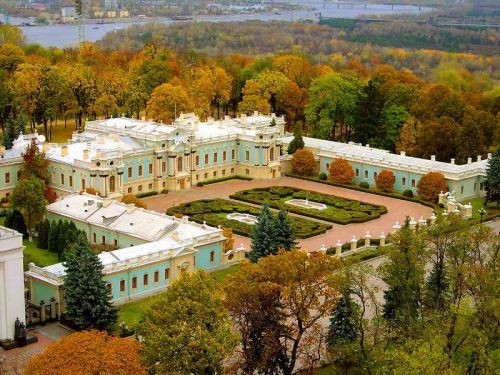
Mariinsky Palace - one of the most beautiful palaces in Ukraine. The impressive Baroque building erected in the 1750-55 by the project architect Rastrelli for the Empress Elizabeth Petrovna, who personally chose the place for it. During the visits in Kiev, here stayed the members of the royal family, including Catherine II, who visited Kiev in 1787. In the XVIII-XIX centuries palace was the residence of the governors-general of the Kiev province. At the moment, the Mariinsky Palace is the ceremonial residence of the President of Ukraine, where are held the receptions at the highest level. It is used solely for official events, as the palace is now under reconstruction. Preserved richly decorated interiors in a classical style with elements of Baroque and Renaissance, antique furniture, chandeliers, paintings by famous artists, mural painting. Initially, the main facade was converted to the City (Tsar) garden, founded in 1748 by the order of Empress Elizabeth. On the opposite side of the palace (now the front) - there is the Mariinsky Park, named after Empress Maria Alexandrovna
St. Vladimir's Cathedral
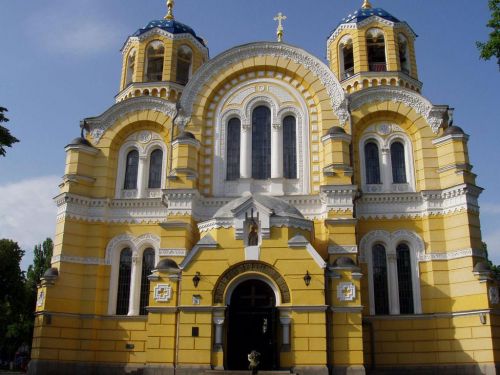
St. Vladimir's Cathedral - a classic example of Russian-Byzantine style of temple architecture. The height of the Cross of the main dome - 49 m. An idea of building in Kiev a magnificent temple in honor of Prince Volodymyr Velikiy came on the eve of the 900th anniversary of the Baptism of Rus. The initial project developed by architector I. Shtrom, but due to the high cost it had to redo it. Construction was commissioned to architect. A. Beretta, but designed building cracked, and construction in 1864 was frozen. The work was completed in 1882 by architect. Nikolaev by the recommendations of the world-renowned expert in vaulted structures R. Berganda. Internal was design under Prof. A. Prahov , who attracted to the work 96 renowned artists, including Vasnetsov, Nesterov, Vrubel, Kotarbinski, Pymonenko who turned St. Vladimir's Cathedral in real artistic jewel. Vladimir's Cathedral was built in the so-called Russian-Byzantine pseudo style. Cathedral in the background - a traditional ancient Russian temple, but topped with 7 towers.